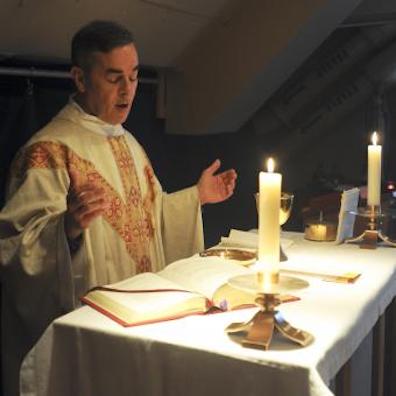Wandering Rocks opens with the confusingly
ambiguous phrase "The superior, the very reverend John
Conmee," and quickly follows up with another play on words:
"What was that boy's name again? Dignam. Yes. Vere dignum
et iustum est." The Latin phrase, "It is truly fitting
and right," comes from the Catholic Mass. Father Conmee here
is simply allowing his mind to wander into a linguistic
coincidence, but the effect must surely be to disorient most
readers.
Conmee is beginning his walk to Artane to see if the
O'Brien Institute for Destitute Children will admit Paddy
Dignam's orphaned son Patsy. He pauses to remind himself of
the family name––clearly these Dignam people are not quite so
immediately available to his consciousness as "Brother Swan,"
"Mr Cunningham," and "the wife of Mr David Sheehy M.P."––and
then his thoughts drift off into a reverie about the Mass. "Vere
dignum et justum est" (or iustum in
ancient Latin) opens the Preface that begins the central
section of the ceremony. Gifford supplies a translation of the
complete sentence: "It is indeed fitting and right, our duty
and our salvation, always and everywhere to give thanks to
you, Lord, Holy Father, Almighty and Eternal God."
Joyce's internal monologue here captures a perfectly ordinary
occurrence in human cognition, the brain's tendency to seize
on casual identities and similarities. But "Vere dignum"
sounds enough like "very Dignam" to make readers of Wandering
Rocks halt their progress and wonder what the priest
may be thinking about the boy. The priest is not thinking
about the boy at all, and the narrative is leading its readers
down a blind alley. The confusion is entirely typical of this
chapter.
For fans of Catholic arcana, however, the alley may not be
entirely blind. While anyone familiar with the Latin Mass
would immediately recognize the words Vere dignum, few
would recognize their presence in the cruciform monogram shown
here in a 12th century manuscript. The text to the right of
the monogram begins "et iustum est" because the
monogram (which appears in at least three different medieval
manuscripts) contains the letters UEREDIGNUM. (Ancient Romans
used just one letter, U or V, derived from the Greek upsilon,
to represent both the u-vowel and the v-consonant. Only in the
Renaissance did scholars begin to distinguish them with two
characters, as they did also with I and J.) In a brief 1 June
2013 article on Corpus Christi Watershed
(www.ccwatershed.org/2013/06/01/uere-dignum-truly-right-just-preface-vere),
Jeff Ostrowski offers a visual explanation of how the
cryptogram works.

